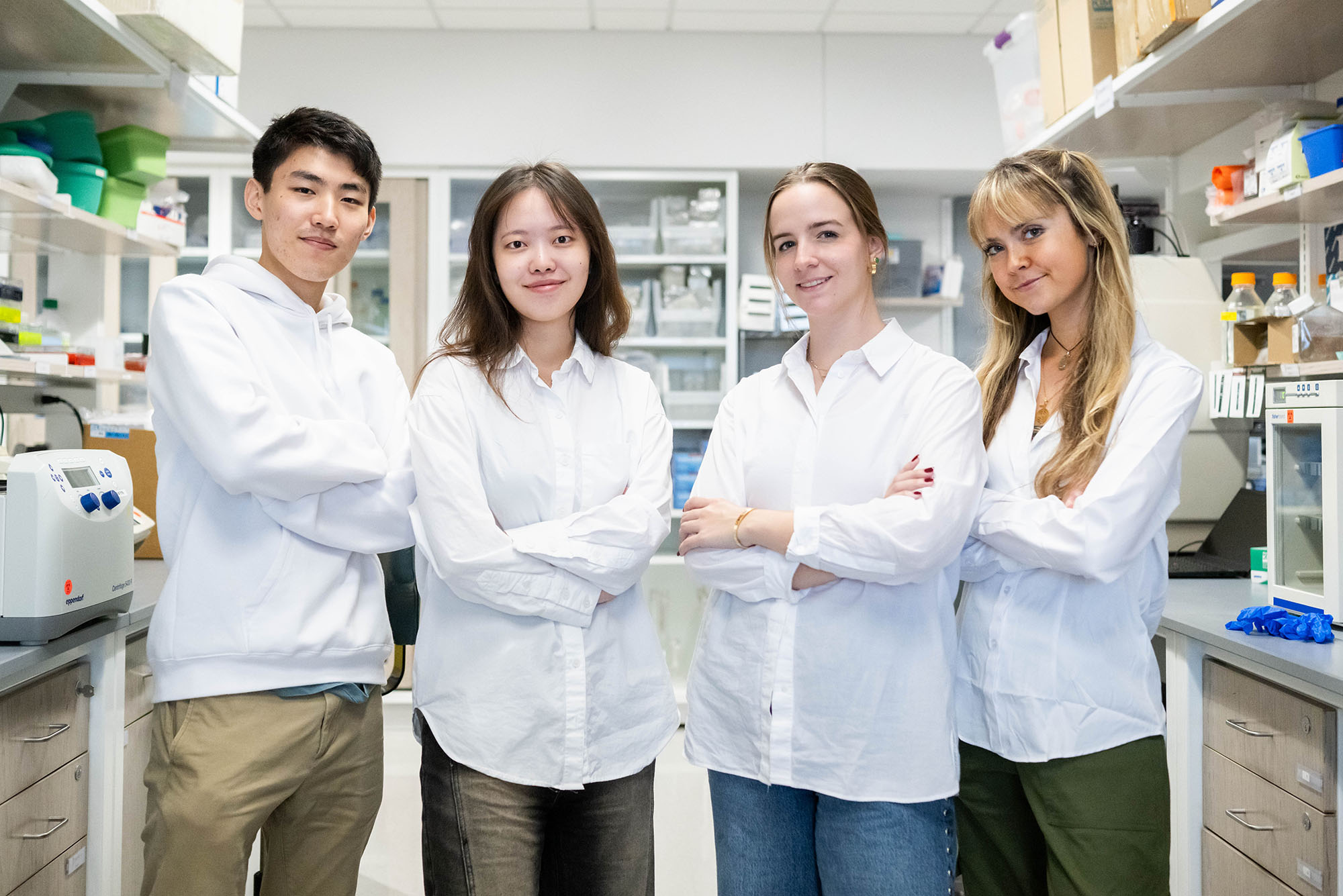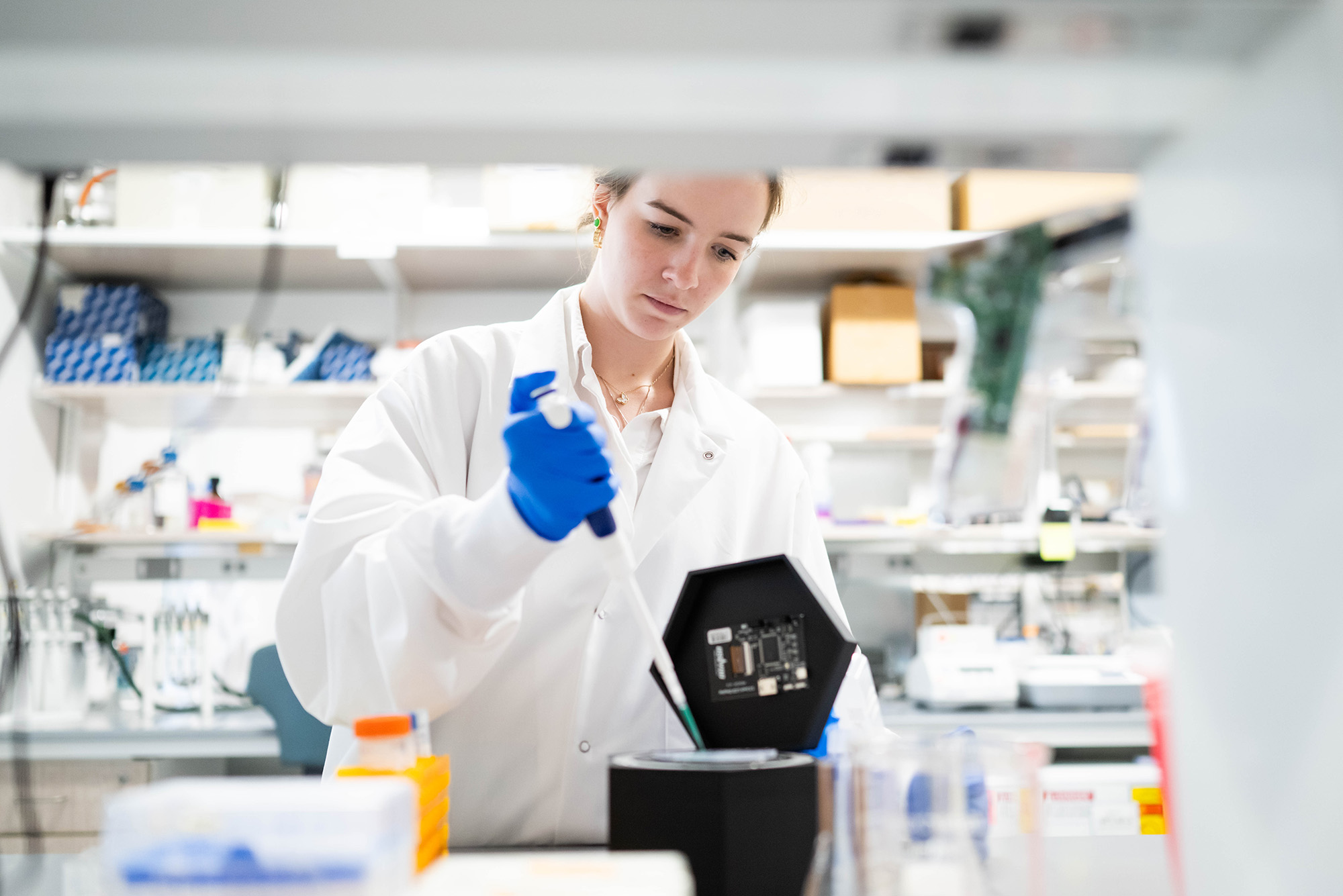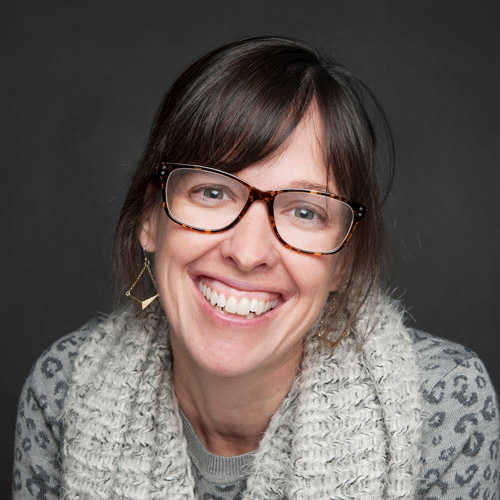BU Students Head to Paris to Compete in International Synthetic Biology Competition
Team will present their device, AgriNOVA, that can detect toxic metals in soil

AgriNOVA team members Kevin Li (ENG’25, CAS’25) (from left), Brenda Kim (CAS’25), Meritxell Ortodo (ENG’26), Trinity Olander (CAS’26), and Abby Smith (ENG’25) (not pictured) are in Paris, demonstrating their novel biosensor that monitors soil for toxic heavy metals.
BU Students Head to Paris to Compete in International Synthetic Biology Competition
Team will present their device, AgriNOVA, that can detect toxic metals in soil
Aiming to keep heavy metals out of the food we eat, a team of Boston University undergrads has traveled to Paris this week to pitch a soil monitor they invented, as part of the annual International Genetically Engineered Machine (iGEM) Grand Jamboree.
Some 427 student teams from around the globe are competing for awards in more than a dozen categories in what one contestant calls “a giant science fair” focused on synthetic biology. And whether or not the Terriers take home a prize, they have crafted a novel solution to a serious public health problem.
Toxic heavy metals from industrial pollution can leach into agricultural soil, eventually winding up in our food. Numerous instances have been reported recently. Earlier this year, Consumer Reports urged the USDA to drop Lunchables from the National School Lunch Program after the nonprofit tested the products and found “concerning levels” of heavy metals, such as lead and cadmium.
Current methods of testing soil for such contaminants involve large chemical analysis machines, and the process—sending samples to a far-off lab and awaiting results—is too expensive and time-consuming for many small farmers in under-resourced regions.
Enter AgriNOVA, the BU student team and their device of the same name. Barely bigger than a toaster oven, the tester contains bacteria that have been genetically engineered to light up when they encounter cadmium or manganese. These light signals are picked up by an optical system embedded in the hardware, and the results are displayed on-screen in a user-friendly format.
The goal is to empower farmers to quickly interpret the data and act upon it. (Soil remediation techniques can include proper waste disposal and a reduction in the use of chemical fertilizers.) Ultimately, the AgriNOVA team envisions a farmer being able to deploy a network of the devices to automatically collect and assess samples from different fields.
“The farmers can use it on-site themselves,” says Trinity Olander (ENG’26), who is majoring in molecular biology. “We want to integrate a mapping system so they can track heavy metals across a farm plot and over time.”
Moreover, the team would like to add more biosensors, widening the scope of the monitor beyond cadmium and manganese. “Both are heavy metals which are really toxic to the environment and also to people” at high levels, says Minseo (Brenda) Kim (CAS’25), a senior majoring in data science and minoring in biology. “But obviously we’re hoping to expand that to other contaminants, such as lead, mercury, and arsenic.”
Best of all, the students say, their streamlined device would be affordable, making the technology available to the largest number of people. “The goal is overall accessibility, since toxic metals in agricultural soil is such a big threat,” says Kim.
“We were struck by the fact that there were no low-cost alternatives in heavy metal detection,” says Meritxell Ortodo (ENG’26), a biomedical engineering major.

That’s why the team plans to make detailed plans for AgriNOVA publicly available. “We developed a DIY, step-by-step guide, with files for laser-cutting, 3D-printing, and other ways to build the device,” says Ortodo. “So for farmers, or engineers working with farmers, or even high school students, say, who don’t have access to the labs we do, here’s a low-cost alternative where they can follow the steps to replicate this device exactly.”
The team also includes Abby Smith (ENG’25), a biomedical engineering major and Kilachand Honors College Scholar, and Kevin Li (ENG’25, CAS’25), who is double majoring in biochemistry and molecular biology and in computer science. This interdisciplinary mix has been a boon to the creation of a device that combines optics, microfluidics, mechanics, and genetic engineering.
“This was just the perfect opportunity and example of how biology could be integrated with hardware and electronics, which was really cool, and the team being so diverse was very helpful,” says Ortodo. “There’s a lot of different perspectives that really build on the idea. Everybody is [learning from] and feeding off each other.”
The team was guided by lead principal investigator Miguel Jimenez, an ENG assistant professor of biomedical engineering, and secondary PI Hailey Gordon, executive director of STEM Pathways, the STEM outreach program based at BU’s Biological Design Center (BDC). STEM Pathways sponsors a BU iGEM team each year.
“They achieved all their goals, working hard, collaboratively,” says Gordon, who also points out that the students benefited from the resources in BDC, such as the DAMP Lab for the biology work, and the CIDAR Lab for the hardware. “I don’t think we’d be able to do the project without either one of those labs’ support,” she says.
The undergrads also consulted with grad student mentors and industry professionals from two farm tech companies, Farmblox and Talam Biotech, to better understand the needs of farmers as well as modern approaches to soil management.
In addition to presenting their own work at the Paris event, the BU students will spend some of the week circulating through the expo’s 14 halls, or “villages,” devoted to different categories, such as diagnostics, space, and biomanufacturing. That’s part of the value, and the excitement, of such a large gathering of young synthetic biology researchers, the team says—although iGEM is a competition, it’s also about networking and advancing science. “We’re making connections and learning about other people’s projects,” Olander says. “It’s building a community.”

Comments & Discussion
Boston University moderates comments to facilitate an informed, substantive, civil conversation. Abusive, profane, self-promotional, misleading, incoherent or off-topic comments will be rejected. Moderators are staffed during regular business hours (EST) and can only accept comments written in English. Statistics or facts must include a citation or a link to the citation.